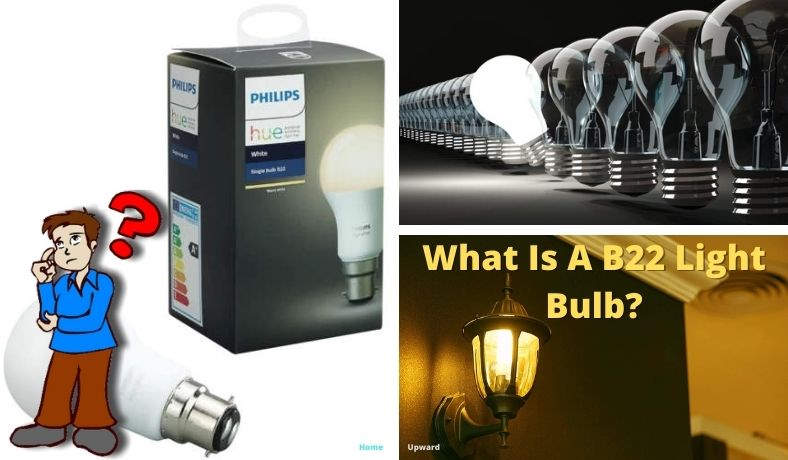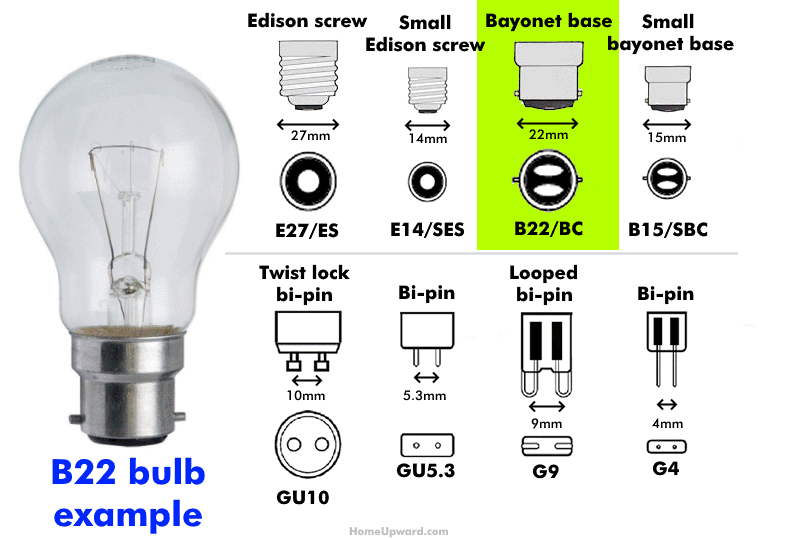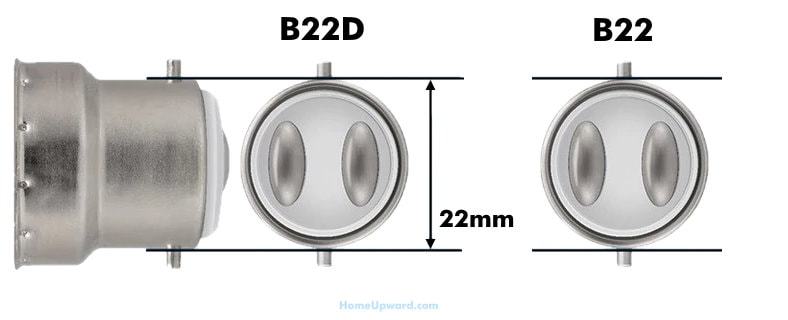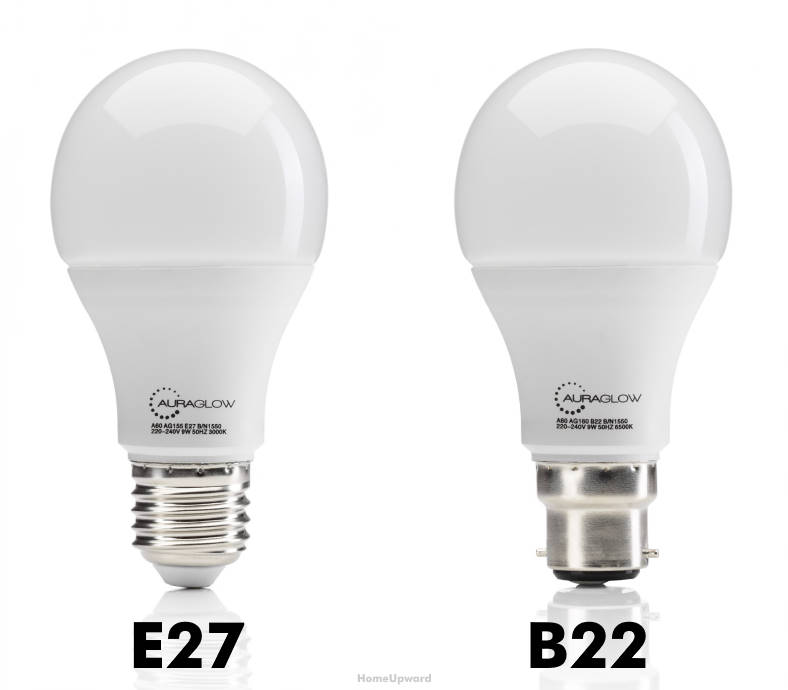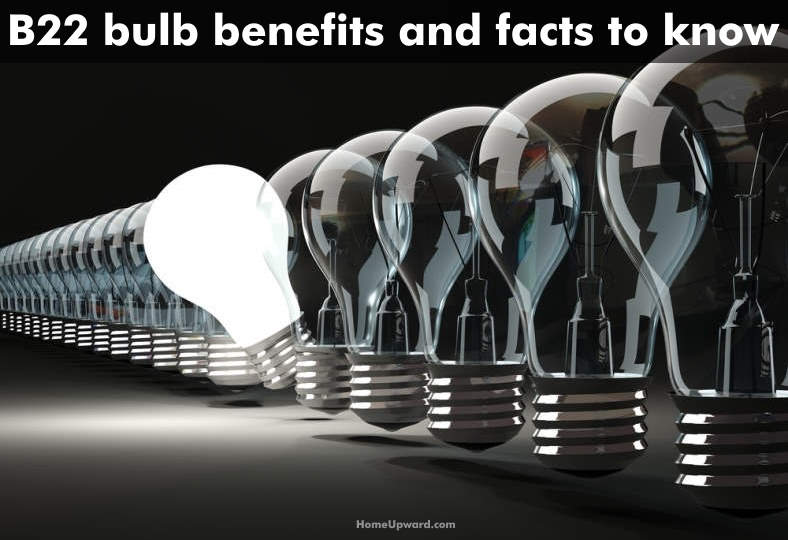Have you ever been shopping for light bulbs and felt overwhelmed? Me too!
Recently I had to replace a burnt-out bulb and had to deal with some things I didn’t understand. What is a B22 light bulb? And what is the purpose of a B22 bulb or socket?
I’d love to help you understand everything to know about B22 bulbs.
Contents
What is a B22 light bulb?
When you see a light bulb box, you’ll often see a long title printed on it with a bunch of numbers and letters that look something like this: “CorePro LEDbulb ND 8-60W A60 B22 827.”
The short answer is that a B22 light bulb is a type of bulb that has a “bayonet” pronged base with a diameter of 22mm (.87″). Bayonet style bases are smooth, rather than the Edison-style that you see the lines to screw it in.
Understanding B22 light bulb specs
A light bulb’s specification number is made up of these specs:
- Supplier: The first part is the supplier or manufacturer identifier. The one listed above is the CorePro series from Phillips, but you may see GE, Sylvania, General, or any other company.
- Style: You can probably immediately recognize a traditional “Edison” light bulb – it’s the most common bulb type. This part of the title just tells you what the style of the bulb is.
- Wattage: Next, you see the wattage, or how much energy the bulb uses. Occasionally you will also see two numbers with a dash (8-60W.) This number will help you relate to the lumens (or brightness output) that the bulb emits.
- Filament type or LED/Lumen Conversion: Some, not all, bulbs will also display a filament type or the pieces within the bulb that help emit the light. Certain types of bulbs will also give a LED or Lumen conversion.
- Bulb Diameter Size: The final part of our example tells you what the base and diameter of the bulb are. The letter part is the base type or the piece that screws into the light socket. B means Bayonet, which is a smoother base that screws in. The number – 22 – is the exact diameter of your bulb in millimeters. So while B15 and B22 bulbs may have the same type of bayonet base, the 15 is smaller and will have a smaller base than the 22.
Some manufacturers, such as Philips, make a range of light bulbs that utilize the B22 base. These bulbs are more energy-efficient, as they use 6 – 13 kWh (kilowatts per hour, or the overall amount of energy consumed.) CorePro LED B22 bulbs have A+ Energy Efficiency Labels (ELL for short.)
I’ve found that it’s relatively easy to find B22 models not only in LED versions but also compatible with dimmers or dimmable switches. That was a relief for me when I went shopping!
Recommended uses for a B22 light bulb
- The traditional B22D bulb is used at home in traditional light fixtures.
- A small-cap version, or SBC, can be found in smaller applications. Double-contact versions are for home lighting while single-contact models are for automotive or machine use.
- Small caps, or MBC, are usually used for industrial applications.
In my experience, it’s pretty common to find B22 style miniature bulbs used for taillights in cars, trucks, and other vehicles.
The B22 socket and how to remove and replace bulbs
A bayonet mount is how the bulb fastens into the fixture. Bayonet mounts are usually a metal cylinder with one or more female receptors. (Or how the bulb latches into the socket.)
To replace a pronged base B22 bulb, you carefully twist the bulb about 90 degrees then pull it out. Never use hard force if it won’t turn easily as you may break the glass bulb off of the base.
Pronged base light bulbs usually can only fit in one way as the prongs are of slightly different heights, or “keyed.” The light bulb socket has openings at the same heights as the prongs and they have a sort of L-shaped slot.
The pins on the base of the bulb fit into the upper part of the L.
Replacement is done in exactly the reverse: insert the bulb and twist it into place by slightly pushing down and turning. Springs inside the bottom of the L help lock the bulb in place in most cases, so expect to need to push down slightly when using a B22 bulb.
What’s the difference between a B22 and a B22D bulb?
Both the B22 and B22D style bulbs use a tabbed bayonet base and use a push and twist movement to install or remove it. There’s no difference between the two – both B22 and B22D are the same. B22D is simply the “official” name for the size and type of base.
These contacts are the slight metal contacts that look like a “bump” at the bottom of the lightbulb’s base. B22/B22D bulbs were a standard type of socket in many former British empire regions. Other styles of bayonet base bulbs are out there as well but the 22mm B22 style is mainly used in homes.
A few other names are used sometimes as well: BC, BA22D B22D, B22D-2, and BC22.
What is the difference between B22 and E27 bulbs?
Both B22 light bulbs and E27 bulbs are great replacements for old halogen bulbs that could use a more energy-efficient LED upgrade.
Both bulbs also handle heat well, so are great picks for high-heat areas, such as above the sink or in a dining room.
Which bulb should I pick?
If you live in an area with earthquakes, tornados, or any area that may experience a lot of vibrations, a B22 bulb and socket could be the better choice. A B22 bulb is a push and twist installation, and replacing the socket is very simple.
The E27 bulb would be a better pick for existing sockets in older homes with old wiring.
Frequently asked questions about B22 lightbulbs
What wattage and voltage do B22 light bulbs come in?
Depending on the manufacturer, you can almost always find B22 bulbs in 40W, 60W, 75W, and 100W. The most common wattage B22s are 60W and 100W.
I have never personally found a 120W, but since LED provides a better lumens (or brightness) output, 60W usually does the trick perfectly.
What wattage B22 should I get?
While most bulbs will display some kind of wattage (W) or voltage (V) printed on the bulb itself, a lumen is actually a better way to measure light output. Watts measure energy use, whereas lumens measure the actual brightness that is omitted.
The FTC published a helpful conversion chart from watts to lumens.
What is a Bayonet cap base?
The most common type of light bulb is an Edison bulb, a bulb attached to a threaded metal base.
A bayonet base is smooth but has a few pins. The pins slip or lock into holes in the socket. These are most popular in Britain but have grown in popularity in Northern America.
Facts and benefits of the B22 light bulb
While the B22 may have come from Britain, it has been around for a long time. Here are some cool facts about this unique light bulb.
Fun facts about the B22 light bulb
- B22s come in incandescent, halogen, CFL, LED, and dimmable options.
- Many B22s have a life rating of 15,000 hours of use – or more!
- Bayonet bases will not come loose with vibration, making them a great choice for people living in highly windy locations or earthquake-susceptible areas.
- The bayonet is a type of base, which means that they can have a wide array of light bulbs and light styles to match your designs.
- B22 LED bulbs are an excellent energy replacement for halogens.
- Most photography cameras use a bayonet-type mount to change out a lens rapidly and lock the lens into place securely.

